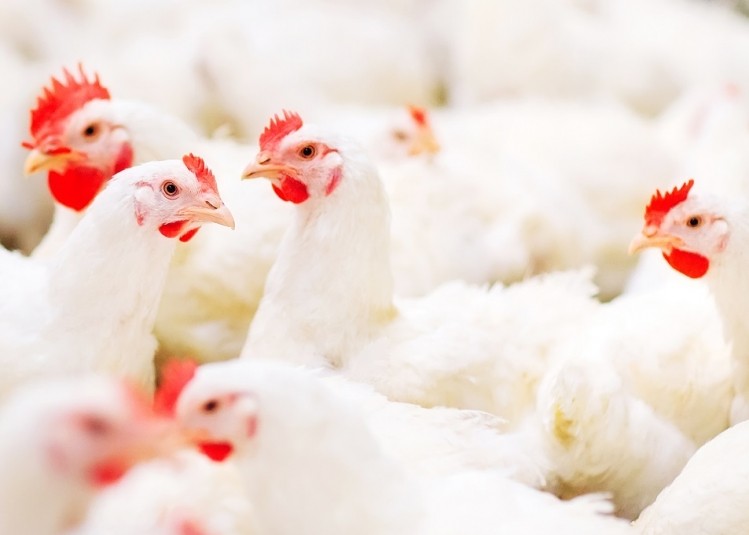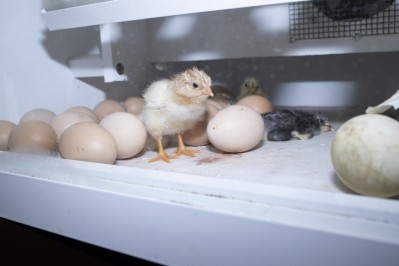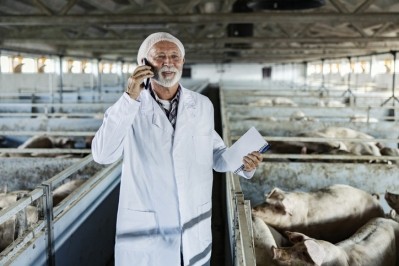Split-feeding program looks to disrupt conventional approaches to broiler breeder nutrition

The new split-feeding system optimizes broiler breeders’ use of nutrients, thereby increasing the number of hatched eggs and chicks produced per hen, said Felipe Sanchez Fernandez, researcher, Trouw Nutrition.
“The feeding system also sets a higher standard of welfare for broiler breeders by decreasing their feeling of hunger, increasing satiety and reducing pecking activity, and the birds’ feathering cover,” he added.
Trouw Nutrition originally carried out work on split-feeding for layer bird production, a system which it commercialized in 2012.
“The large broiler breeder integrators saw the positives for the environment and for feed costs stemming from the layer bird split-feeding system, and requested a similar feeding model for their sector,” Sanchez Fernandez told FeedNavigator.
The last year saw the company involved in the patent process for the broiler breeder split-feeding concept, which is now seeing commercial rollout. Latin America is the initial target market, with it then being marketed worldwide. ForFarmers has already been implementing the system in the Benelux markets, though, while it has also been tested with poultry integrators in Spain though the Nutreco-owned SADA group.
Trouw Nutrition is looking at the idea of issuing patent licenses for the system in certain markets, as part of the commercial rollout.
The concept
Broiler breeder hens are usually given restricted diets once a day, but Trouw Nutrition says that numerous studies had suggested that this method was falling short in terms of achieving optimal nutrient use.
Also research shows that birds’ circadian rhythms, based on their physiological needs for egg formation, affect their intake of nutrients, said Sanchez Fernandez. Laying hens have specific nutrient requirements throughout the day according to the formation process of the different component of the eggs, he added.
By feeding birds twice daily, farmers can deliver a more precise supply of key nutrients in the diet, tailored to the daily requirements of the bird, he continued.
Split-feeding sees hens get a morning feed that delivers the nutrition for energy, protein and phosphorus for the egg-laying production. The afternoon feed meets the requirements for eggshell formation.
More efficient intake can lead to a reduction in CO2 of 10%. The related decline in excreted nutrients further supports sustainability, according to the company.
It outlined the key financial benefits of split feeding for broiler breeders:
- Reduction of feed cost of 3%-7% per chick hatched
- €6/MT compound feed
- +3-9% gross margin/hen
Broiler breeder integrators using the new feeding system would be required to have two silos per house, but the financial savings afforded by the model would offset any initial outlay for producers needing to purchase additional silos, stressed Sanchez Fernandez.
At the outset, Trouw Nutrition will provide on-site guidance to producers to help them manage the split-feeding model on farm. A certain level of technical expertise is required to ensure the efficacy of the split-feeding system. But this is not an issue in broiler breeder production, a sector known for its high standard of professionalism, and technical innovation, he said.
Split-feed model development
In 2005, Trouw Nutrition R&D began an experimental program focused on the development of a split-feeding program for laying hens. The program was commercialized in 2012 and, following the first successful results, the company decided to inaugurate the second experimental period, from 2014 to 2018, and develop a split-feeding program for broiler breeders.
In 2014, Trouw Nutrition’s poultry R&D center launched a trial to validate the split-feeding concept in broiler breeders.
The trial used broiler breeders from 53 to 63 weeks of age. A total of 2,560 Ross 308 breeder females were allocated to 20 pens, with 128 birds per pen. Each pen was also filled with 11 Ross 308 breeder males.
The birds in 10 of these pens were fed a standard diet at 6am, whereas the birds in the other 10 pens followed a split-feeding program consisting of a morning diet and an afternoon diet.
After validating the split-feeding concept for broiler breeders in-house, the company decided to test the concept on commercial farms. Three validation field trials were held at the SADA company in Spain, from May 2015 to November 2018. The trial involved 122,600 breeders (Ross/Cobbs), five farmers and 12 houses. Split-feeding was tested against a control diet on all farms, and different feeder systems were also used, such as chain and plate feeders.
The following parameters applied to all three trials:
- Breeders/Hatchery: performance and economic results
- Eggshell quality and bone mineralization
- Animal welfare, e.g. pecking behavior
- Gut health, immunity, abdominal fat
- Effect on the progeny
Results of the SADA field trials
The company said the commercial field trials demonstrated that farmers obtain +1.9 more chicks hatched per hen house in the flocks fed with split-feeding than in the control flocks. The feed cost per hatched chick went down by 9%. Flocks fed using the split feeding system also displayed significant improvements on eggshell quality parameters such as weight, thickness, breaking strength and shell weight per unit of surface area (SWUSA), it added.













